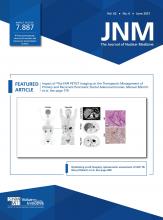Research ArticleFeatured Article of the Month
Impact of 68Ga-FAPI PET/CT Imaging on the Therapeutic Management of Primary and Recurrent Pancreatic Ductal Adenocarcinomas
Manuel Röhrich, Patrick Naumann, Frederik L. Giesel, Peter L. Choyke, Fabian Staudinger, Annika Wefers, Dawn P. Liew, Clemens Kratochwil, Hendrik Rathke, Jakob Liermann, Klaus Herfarth, Dirk Jäger, Jürgen Debus, Uwe Haberkorn, Matthias Lang and Stefan A. Koerber
Journal of Nuclear Medicine June 2021, 62 (6) 779-786; DOI: https://doi.org/10.2967/jnumed.120.253062
Manuel Röhrich
1Department of Nuclear Medicine, Heidelberg University Hospital, Heidelberg, Germany
Patrick Naumann
2Department of Radiation Oncology, Heidelberg University Hospital, Heidelberg, Germany
3National Center for Tumor diseases (NCT), Heidelberg, Germany
4Heidelberg Institute of Radiation Oncology (HIRO), Heidelberg, Germany
Frederik L. Giesel
1Department of Nuclear Medicine, Heidelberg University Hospital, Heidelberg, Germany
5German Cancer Consortium (DKTK), partner site Heidelberg, Germany
Peter L. Choyke
6Molecular Imaging Program, Center for Cancer Research, National Cancer Institute, National Institutes of Health, Bethesda, Maryland
Fabian Staudinger
1Department of Nuclear Medicine, Heidelberg University Hospital, Heidelberg, Germany
Annika Wefers
7Department of Neuropathology, Institute of Pathology, University Hospital Heidelberg, Heidelberg, Germany
8Clinical Cooperation Unit Neuropathology, German Consortium for Translational Cancer Research (DKTK), German Cancer Research Center (DKFZ), Heidelberg, Germany
Dawn P. Liew
1Department of Nuclear Medicine, Heidelberg University Hospital, Heidelberg, Germany
Clemens Kratochwil
1Department of Nuclear Medicine, Heidelberg University Hospital, Heidelberg, Germany
Hendrik Rathke
1Department of Nuclear Medicine, Heidelberg University Hospital, Heidelberg, Germany
Jakob Liermann
2Department of Radiation Oncology, Heidelberg University Hospital, Heidelberg, Germany
3National Center for Tumor diseases (NCT), Heidelberg, Germany
4Heidelberg Institute of Radiation Oncology (HIRO), Heidelberg, Germany
Klaus Herfarth
2Department of Radiation Oncology, Heidelberg University Hospital, Heidelberg, Germany
3National Center for Tumor diseases (NCT), Heidelberg, Germany
4Heidelberg Institute of Radiation Oncology (HIRO), Heidelberg, Germany
Dirk Jäger
9Department of Medical Oncology and Internal Medicine Virgin Islands, National Center for Tumor Diseases, University Hospital Heidelberg, Germany
10Clinical Cooperation Unit Applied Tumor Immunity, German Cancer Research Center (DKFZ), Heidelberg, Germany
Jürgen Debus
2Department of Radiation Oncology, Heidelberg University Hospital, Heidelberg, Germany
3National Center for Tumor diseases (NCT), Heidelberg, Germany
4Heidelberg Institute of Radiation Oncology (HIRO), Heidelberg, Germany
5German Cancer Consortium (DKTK), partner site Heidelberg, Germany
11Heidelberg Ion-Beam Therapy Center (HIT), Department of Radiation Oncology, Heidelberg University Hospital, Heidelberg, Germany
12Clinical Cooperation Unit Radiation Oncology, German Cancer Research Center (DKFZ), Heidelberg, Germany
Uwe Haberkorn
1Department of Nuclear Medicine, Heidelberg University Hospital, Heidelberg, Germany
5German Cancer Consortium (DKTK), partner site Heidelberg, Germany
13Clinical Cooperation Unit, Department of Nuclear Medicine, German Cancer Research Center (DKFZ), Heidelberg, Germany
14Translational Lung Research Center Heidelberg, Member of the German Center for Lung Research DZL, Heidelberg, Germany; and
Matthias Lang
7Department of Neuropathology, Institute of Pathology, University Hospital Heidelberg, Heidelberg, Germany
15Department of Surgery, Heidelberg University Hospital, Heidelberg, GermanyMember of the German Center for Lung Research DZL, Heidelberg, Germany
Stefan A. Koerber
2Department of Radiation Oncology, Heidelberg University Hospital, Heidelberg, Germany
3National Center for Tumor diseases (NCT), Heidelberg, Germany
4Heidelberg Institute of Radiation Oncology (HIRO), Heidelberg, Germany

Data supplements
Supplemental Data
Files in this Data Supplement:
In this issue
Journal of Nuclear Medicine
Vol. 62, Issue 6
June 1, 2021
Impact of 68Ga-FAPI PET/CT Imaging on the Therapeutic Management of Primary and Recurrent Pancreatic Ductal Adenocarcinomas
Manuel Röhrich, Patrick Naumann, Frederik L. Giesel, Peter L. Choyke, Fabian Staudinger, Annika Wefers, Dawn P. Liew, Clemens Kratochwil, Hendrik Rathke, Jakob Liermann, Klaus Herfarth, Dirk Jäger, Jürgen Debus, Uwe Haberkorn, Matthias Lang, Stefan A. Koerber
Journal of Nuclear Medicine Jun 2021, 62 (6) 779-786; DOI: 10.2967/jnumed.120.253062
Impact of 68Ga-FAPI PET/CT Imaging on the Therapeutic Management of Primary and Recurrent Pancreatic Ductal Adenocarcinomas
Manuel Röhrich, Patrick Naumann, Frederik L. Giesel, Peter L. Choyke, Fabian Staudinger, Annika Wefers, Dawn P. Liew, Clemens Kratochwil, Hendrik Rathke, Jakob Liermann, Klaus Herfarth, Dirk Jäger, Jürgen Debus, Uwe Haberkorn, Matthias Lang, Stefan A. Koerber
Journal of Nuclear Medicine Jun 2021, 62 (6) 779-786; DOI: 10.2967/jnumed.120.253062
Jump to section
Related Articles
Cited By...
- SNMMI Procedure Standard/EANM Practice Guideline for Fibroblast Activation Protein (FAP) PET
- Acquisition Duration Optimization Using Visual Grading Regression in [68Ga]FAPI-46 PET Imaging of Oncologic Patients
- Diagnostic Potential of Supplemental Static and Dynamic 68Ga-FAPI-46 PET for Primary 18F-FDG-Negative Pulmonary Lesions
- 18F-FAPI-04 Outperforms 18F-FDG PET/CT in Clinical Assessments of Patients with Pancreatic Adenocarcinoma
- Value of 68Ga-FAPI-04 and 18F-FDG PET/CT in Early Prediction of Pathologic Response to Neoadjuvant Chemotherapy in Locally Advanced Gastric Cancer
- Spatial transcriptomic analysis drives PET imaging of tight junction protein expression in pancreatic cancer theranostics
- Immunohistochemical FAP Expression Reflects 68Ga-FAPI PET Imaging Properties of Low- and High-Grade Intraductal Papillary Mucinous Neoplasms and Pancreatic Ductal Adenocarcinoma
- 68Ga-Labeled Fibroblast Activation Protein Inhibitor (68Ga-FAPI) PET for Pancreatic Adenocarcinoma: Data from the 68Ga-FAPI PET Observational Trial
- Impact of 68Ga-FAPI PET/CT on Staging and Oncologic Management in a Cohort of 226 Patients with Various Cancers
- Evaluation of the Diagnostic Accuracy of FAPI PET/CT in Oncologic Studies: Systematic Review and Metaanalysis
- Tumor Characterization by [68Ga]FAPI-46 PET/CT Can Improve Treatment Selection for Pancreatic Cancer Patients: An Interim Analysis of a Prospective Clinical Trial
- Evaluation of the Diagnostic Accuracy of FAPI PET/CT in Oncologic Studies: Systematic Review and Metaanalysis
- 68Ga-FAPI PET/CT Interobserver Agreement on Tumor Assessment: An International Multicenter Prospective Study
- Three-Time-Point PET Analysis of 68Ga-FAPI-46 in a Variety of Cancers
- Static and Dynamic 68Ga-FAPI PET/CT for the Detection of Malignant Transformation of Intraductal Papillary Mucinous Neoplasia of the Pancreas
- Repetitive Early 68Ga-FAPI PET Acquisition Comparing 68Ga-FAPI-02, 68Ga-FAPI-46, and 68Ga-FAPI-74: Methodologic and Diagnostic Implications for Malignant, Inflammatory/Reactive, and Degenerative Lesions
- Pitfalls and Common Findings in 68Ga-FAPI PET: A Pictorial Analysis
- Fibroblast Activation Protein-Specific PET/CT Imaging in Fibrotic Interstitial Lung Diseases and Lung Cancer: A Translational Exploratory Study
- 68Ga-FAPI as a Diagnostic Tool in Sarcoma: Data from the 68Ga-FAPI PET Prospective Observational Trial






